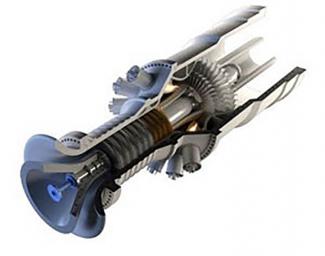Turbines are essential in meeting America’s power demands, producing electricity at virtually every power plant in the United States. With fossil fuels projected to remain the dominant source of energy for decades to come, advanced combustion turbine technology will play a critical role in capitalizing on the nation’s vast domestic resources.
While many energy technologies are focused on one specific application, advanced combustion turbines offer versatility in their ability to be adapted for use in a variety of power systems – including those fueled by coal or natural gas, combined with pre- or post-combustion carbon capture. NETL’s work to improve advanced combustion turbines seeks to boost overall turbine efficiency, cut the cost of electricity, reduce pollutant emissions and enable more affordable carbon capture options.
NETL’s turbine program focuses on developing advanced components for the next generation of combustion turbines. By working to improve components, rather than complete turbines, the benefits are realized in a shorter time frame through industry partnerships. The Lab’s advances in turbine research can be easily applied to existing and future product lines, leveraging existing equipment and products for component demonstration. Pushing components out to the current fleet during maintenance operations continually boosts efficiency for power customers, without delays for a complete market-ready product.
A combustion turbine comprises three primary sections – a compressor, a combustion system and turbine expander. As air enters the turbine, it’s compressed and pressurized before being combusted with a fossil fuel – often natural gas, or coal-based synthesis gas or hydrogen. The high-temperature, high-pressure gas stream expands as it moves through the turbine blades, or airfoils, causing them to spin quickly. A generator then converts that mechanical energy into electricity. In a combined-cycle power system, exhaust heat is recovered and used to create steam, which produces additional electricity through a steam turbine.
NETL’s efforts to improve advanced combustion turbines are focused on boosting efficiency beyond 65 percent for combined-cycle systems using natural gas, which equates to about 60 percent efficiency for combined-cycle systems using coal. Greater temperatures – around 3,100 degrees Fahrenheit as air enters the turbine – are the key to achieving those efficiencies. However, higher heat introduces new challenges: material limitations, cooling measures, potential for gas leakage, rising manufacturing costs, and increased emissions.
NETL is working with a variety of external partners to improve turbine components by addressing these issues through research and development (R&D) of key technologies, including the following:
- Ceramic matrix composite (CMC) components. Ceramic-based composite materials offer added strength and heat resistance amid the turbine’s harsh temperatures. Turbine components made from these materials curb cooling requirements and increase efficiency, particularly for a combined-cycle system using coal syngas.
- Heat transfer and material systems. Special alloys, advanced airfoil designs, novel cooling techniques and heat-protective coatings help to optimize performance of cooling features and turbine materials at extreme temperatures.
- Advanced transition sections. Changes in the design of the transition area between the combustion chamber and the rotating turbine offer the opportunity to reduce cooling air and leakage, cut nitrogen oxide emissions at higher temperatures, limit aerodynamic losses, and shrink the size of the turbine.
More than 30 active projects are ongoing with university and industry partners, as well as other national labs. Most recently, in April 2018, the U.S. Department of Energy awarded nearly $3.5 million to three industry partners for a total of seven cost-shared research projects managed by NETL and aimed at developing advanced turbine technologies for 65-percent efficiency in combined-cycle power systems. General Electric (GE) will tackle three projects focused on improving airfoils, rotor system designs and heat transfer technologies. Siemens Energy will handle three design projects – one for advanced turbine vanes made from CMCs, another employing a specific cooling technique for turbine blades and a third to create a better high-temperature combustor. For the final project, United Technologies Research Center will develop a conceptual design for high-pressure turbine vanes made from CMCs.
NETL’s goal is to move from bench-scale R&D to small-scale component testing by 2020, have full-scale pilot component testing under way by 2025 and effectively demonstrate 65 percent efficiency for utility-scale combined-cycle operations using natural gas and coal syngas by 2030 or sooner.
Combustion power plants already offer some of the most cost-effective, efficient and clean fossil fuel power cycles available today. NETL’s efforts to steadily improve these systems by developing advanced turbine components will help to not only rejuvenate the coal industry and stimulate the nation’s economy, but also promote responsible stewardship of the environment and ensure America’s continued energy dominance.
To learn more about the Lab’s Advanced Turbines Program, click here.
Contact:




